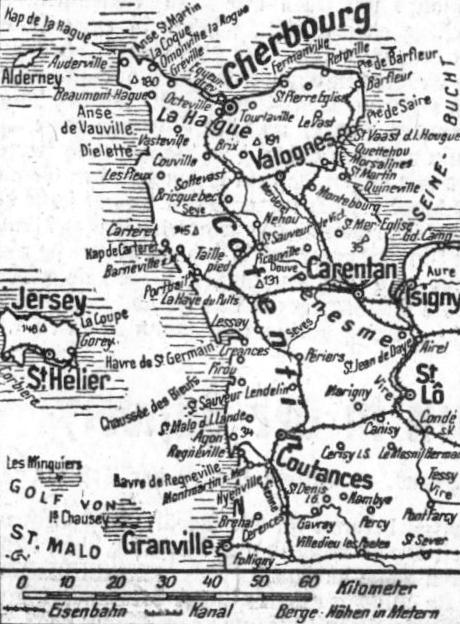Völkischer Beobachter (June 16, 1944)
Bewegungskrieg auf engem Raum
Verzweifelt ringen die Eindringlinge in der Normandie um Entfaltungsmöglichkeiten
vb. Wien, 15. Juni –
Der Kampf in der Normandie beginnt immer mehr die Züge zu tragen, die ihm die starken Panzerverbände von beiden Seiten geben. Das bedeutet, daß er immer mehr die Züge des Bewegungskrieges annimmt. Aber zugleich sind in der Normandie die Wesensmerkmale des Bewegungskrieges so verändert, daß zum Schluss doch – bisher wenigstens – die schnelle Veränderung des Frontverlaufs, die eigentlich zum Begriff des Bewegungskrieges gehört, aufgehoben erscheint.
Wir sehen starke Panzergeschwader vorbrechen, wir sehen sie mit ihrer beträchtlichen Geschwindigkeit gewisse Strecken Landes durchqueren, aber wir sehen auch, daß der Frontverlauf nach Westen und Süden immer noch, wenigstens im Großen gesehen, derselbe ist wie gegen Ende vergangener Woche. Der Gegner ist seit acht Tagen bestrebt, den Brückenkopf mit Hilfe seiner Panzerdivisionen zu erweitern. Er kann seine Angriffe wohl über eine gewisse Strecke vortragen, er stößt aber dann auf heftigen deutschen Gegendruck und auf Gegenangriffe und wird gezwungen, das eben noch gewonnene Gebiet wieder aufzugeben. Es ist also eine im taktischen Verlauf etwas seltsame Form des Panzerkrieges, die sich hier abspielt, gleichsam ein Bewegungskrieg auf engem Raum. Natürlich ist die Front hier nicht erstarrt, wie sie es 1917 war, sie ist flüssig und unaufhörlich in Veränderung begriffen. Aber im Ganzen ändert sich die Gesamtlinie nur sehr wenig.
Auch die Gegner berichten, daß sie am Mittwoch eine Reihe der Dörfer und Kleinstädte, die sie zunächst nach Süden und Nordwesten hingenommen hatten, wieder aufgeben mußten, daß sie da und dort wieder „hinausgeworfen“ worden sind. Auch sie können nicht bestreiten, daß sowohl ihre Versuche, nach der Tiefe Raum zu gewinnen, wie die anderen, sich Cherbourg vom Rücken her zu nähern, erfolglos geblieben sind. Ihre Angriffe in den letzten vierundzwanzig Stunden beweisen von neuem, wie stark Montgomery unter dem strategischen Zwang steht, anzugreifen. Die Angriffe der letzten Tage sind denn auch mit noch größerer Wucht und Kraft unternommen worden wie die der Vortage. Aber sie sind dafür auch wieder auf noch stärkeren deutschen Gegendruck gestoßen. Die Schlacht hat also noch an Umfang wie an Erbitterung zugenommen. Aber am Ende der hin und her wogenden Kämpfe stand dann fast die gleiche Frontlinie wie vorher.
Wir haben also das merkwürdige Bild, daß große Verbände einer starken und schnellen Waffe miteinander kämpfen, daß ihr Einsatz immer stärker wird und daß die Gesamtentwicklung doch etwas Ruhendes hat. Das bedeutet nicht, daß der Einsatz der Kräfte nicht noch gesteigert werden kann. Wir müssen versuchen, uns in die Gedanken des Gegners zu versetzen. Nach dem, was er vorher ausgeplaudert hat, aber auch nach dem objektiven Bild der Lage, hat er sich den Verlauf der Schlacht ganz anders vorgestellt.
Er hat geglaubt, leichter an Land zu kommen, er hat geglaubt, bessere Landeplätze zu linden, und er hat geglaubt, nach neun Tagen tiefer im Lande zu sein. Vor allen Dingen hat er geglaubt, mit weniger Verlusten davonzukommen, als es nun der Fall ist.
Die Darstellungen der englischen und amerikanischen Kriegsberichter sprechen da eine deutliche Sprache. Wenn der General Montgomery den Anschluss an den ursprünglichen „Fahrplan“ Eisenhowers wiedergewinnen will, muß er den Zwang zum Angriff sehr stark empfinden. Der gleiche Zwang geht von seiner gegenwärtigen Lage aus. Er hat keinen rechten Raum zur Entfaltung seiner Heeresgruppe. Er muß sehen, daß er ihn sich schafft.
Er wird kaum mit sehr leichten Gefühlen in den neuen Abschnitt der Invasion gehen. Er spürt den wachsenden deutschen Gegendruck, er liest die Zahlen der schweren Verluste. Dazu muß seine Sorge um den Nachschub sich von Tag zu Tag vergrößern. Je mehr sich die deutsche Luftwaffe und die leichten deutschen Seestreitkräfte auf den Kampf an der normannischen Küste haben einstellen können, umso häufiger und erfolgreicher sind sie am Feind. Die Versenkungszahlen der Wehrmachtberichte sprechen eine deutliche Sprache. Die Behinderung des Nachschubs ist umso empfindlicher für Montgomery, als er ja auch gezwungen ist, für die starken Ausfälle an Menschen und Material Ersatz herbeizuschaffen und damit die ohnehin beschränkten Möglichkeiten der Anlandungen noch zu überanstrengen.
Aber wir möchten annehmen, daß Montgomery trotz aller dieser Erschwernisse dem Zwang der Lage gehorchen wird, der ihm befiehlt anzugreifen. Vermutlich werden seine Vorstöße an Stärke wie an Heftigkeit noch zunehmen, er wird damit versuchen, sich den Weg aus der Enge des Raumes zu bahnen.
Auch der Wehrmachtbericht sagt, daß die Schlacht in der Normandie ihrem Höhepunkt zustrebt. Sie verläßt allmählich das Stadium der Einleitung und der Vorbereitung. Sie nähert sich dem entscheidenden Stadium. Es muß wiederholt werden, daß diese Entscheidungen kaum in einem einzigen Schlage lallen werden. Nach menschlichem Ermessen werden sie in einer Reihe von großen Kämpfen herbeigeführt werden.


